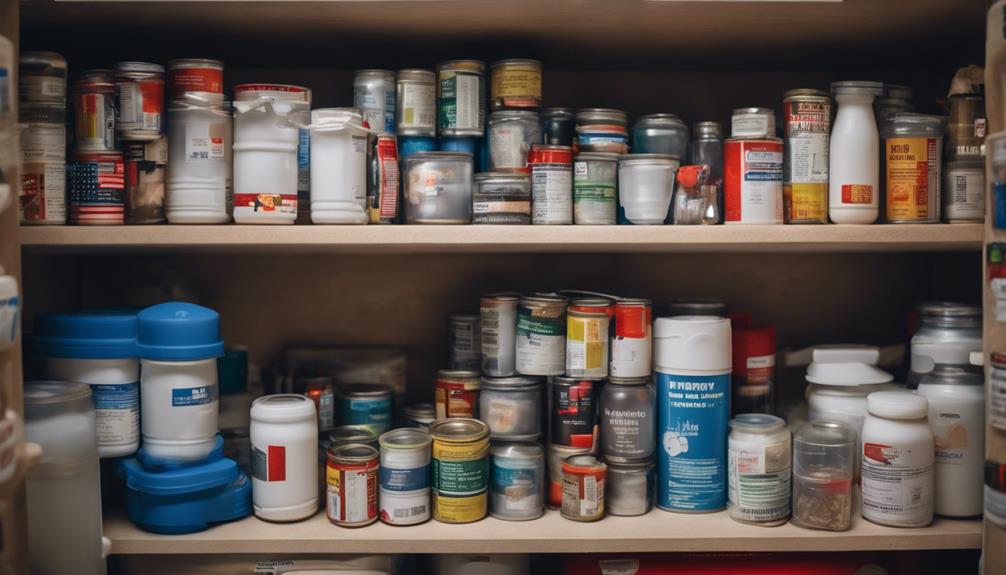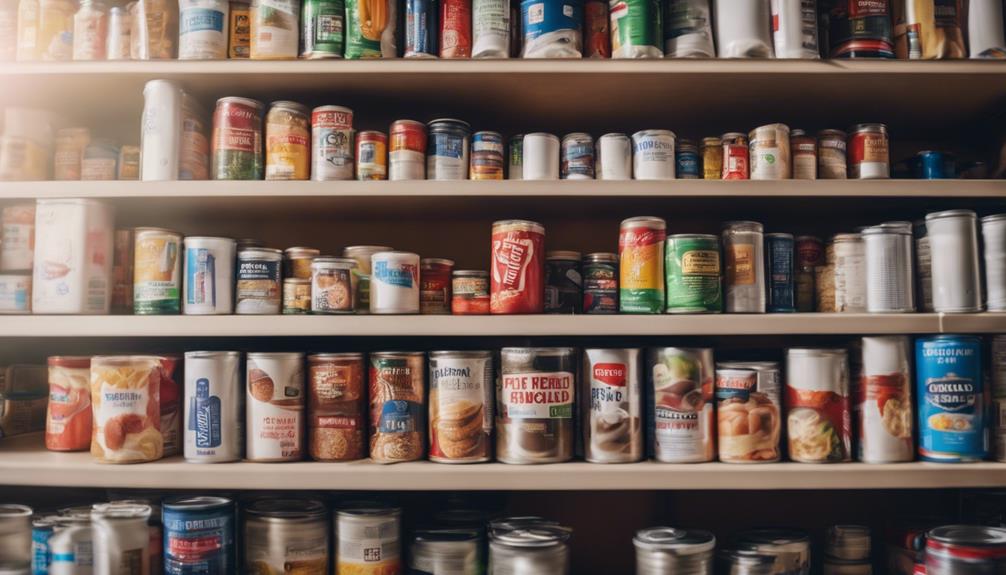Navigating the challenges of supply chain disruptions requires staying ahead of the curve. To mitigate impending shortages, monitor global shipping crises and geopolitical conflicts, diversify your sourcing locations, and stock up on long-term storage items like freeze-dried foods. Develop a thorough emergency preparedness plan, and prioritize resilient supply chains. Diversify your food sources, and explore lab-grown meats and self-sustainable options. Don't forget to stockpile essential items, including non-perishable foods, medical supplies, and hygiene products. By taking these steps, you'll be better equipped to face the uncertainties ahead – and there's more to learn about building a resilient future.
Key Takeaways
- Monitor global shipping crises and geopolitical conflicts to anticipate potential shortages and disruptions.
- Diversify sourcing locations for essential goods to reduce dependence on single suppliers or regions.
- Stock up on long-term storage items like freeze-dried foods and toiletries to prepare for extended disruptions.
- Implement risk management strategies with partners and stay informed about global trends to build resilient supply chains.
- Develop a comprehensive emergency preparedness plan that includes alternative power sources, water storage, and purification methods.
Anticipating Future Shortages
Stay one step ahead of the game by keeping a pulse on the global shipping crisis and its ripple effects on the supply chain, making sure you're prepared for potential shortages before they become a harsh reality.
As you monitor the situation, consider diversifying your sources for essential goods to mitigate potential scarcity risks. This survival skill will help you stay ahead of potential shortages and guarantee you're not caught off guard.
You can't predict when a shortage will hit, but by being informed, you can prepare for the unexpected. Stocking up on long-term storage items like freeze-dried foods will give you a safety net in case of an emergency.
Remember, it's not about being paranoid, it's about being prepared. By anticipating future shortages, you'll be able to adapt quickly and stay ahead of the curve.
Keep a close eye on geopolitical conflicts and maritime bans that could disrupt critical trading routes, and make sure you have a well-rounded emergency preparedness plan in place. With these strategies, you'll be ready for whatever the supply chain throws your way.
Building Resilient Supply Chains

By proactively diversifying your sourcing locations and alternative transportation methods, you can greatly strengthen your supply chains against potential disruptions. This strategic approach enables you to mitigate the risks associated with relying on a single supplier or transportation mode.
Additionally, leveraging technology like blockchain can enhance transparency and traceability in the supply chain, allowing you to quickly identify and respond to potential issues.
Implementing risk management strategies is also essential to guarantee continuity of essential supplies. This involves collaborating with suppliers and partners to develop contingency plans and maintain open communication channels.
Staying informed about global trends and geopolitical developments is equally significant, as it enables you to proactively address potential supply chain challenges. By taking these proactive measures, you can build resilient supply chains that can withstand disruptions and ensure the continuous flow of essential goods.
Diversifying Food Sources

You're taking a proactive approach to food security by exploring alternative sources and options beyond traditional suppliers, recognizing that a single point of failure can have devastating consequences. As Americans, you're diversifying food sources due to threats like supply chain disruptions, focusing on alternative options like lab-grown meats and freeze-dried beef. Growing interest in self-sustainability has led to a shift towards reducing dependency on traditional food sources and exploring new ways to guarantee food security.
| Alternative Food Source | Benefits |
|---|---|
| Lab-grown meats | Sustainable, reduced environmental impact |
| Freeze-dried beef | Long-term storage, reliable protein source |
| Home gardens | Fresh produce, increased self-sufficiency |
Having 3 to 6 months' worth of basic staples and food at home can mitigate shortages and uncertainties in the supply chain. With rising demand for high-quality freeze-dried beef as a long-term food storage option, you're providing a reliable source of protein during shortages. By exploring alternative food sources and sustainable options, you'll stay ahead of potential supply chain issues and safeguard food availability in times of crisis.
Emergency Water Storage Tips

Stocking up on emergency water storage is crucial, as access to clean drinking water can be disrupted during supply chain shortages or natural disasters. You'll want to store at least one gallon of water per person per day for drinking and sanitation needs. To guarantee the water remains safe and clean, use food-grade water storage containers to prevent contamination.
Here are three key considerations for your emergency water storage plan:
- Rotate your stored water every 6 months to maintain freshness and quality.
- Plan for at least a 3-day supply of water for emergencies, with additional reserves for longer disruptions.
- Consider alternative solutions, such as water purification tablets or filters, for long-term water storage needs.
Essential Items to Stockpile

Having secured a reliable emergency water storage plan, you can now focus on building a well-rounded stockpile of essential items to guarantee your household's needs are met during supply chain disruptions or natural disasters. As you start building your stockpile, prioritize non-perishable foods, medical supplies, and hygiene products.
Don't forget to include items like batteries, flashlights, and portable chargers, which will come in handy during power outages or emergency situations. Additionally, consider the specific needs of your household, including dietary restrictions, medication requirements, and special care items.
Remember to stock up on basic necessities like toiletries, pet food, and baby supplies. It's also important to store important documents, such as insurance policies and identification, in a safe and accessible location.
To make sure your stockpile remains usable, rotate items regularly, especially perishable goods like canned foods and medications. By having a thoughtfully curated stockpile, you'll be better equipped to handle supply chain shortages and natural disasters, and can focus on keeping your household safe and healthy.
Mitigating Shipping Delays

As a Prepper, you're keenly aware that shipping delays can have a major impact on your ability to stockpile essential supplies. With the current maritime ban, rerouting of cargo ships, and labor shortages, it's more important than ever to anticipate delayed shipments and plan accordingly.
Anticipate Delayed Shipments
You can expect a minimum of 2-4 week delays in receiving essential supplies due to the global shipping crisis and its ripple effects on the supply chain. As a Prepper, it's important to anticipate these delays to make sure you're prepared for any situation.
The current maritime ban in Malaysia on Israel-affiliated vessels has led to rerouting, increasing operational costs, and adding to the delay. Additionally, geopolitical conflicts in the Red Sea region are forcing shipping giants to divert routes, adding weeks to journeys.
Here are some key factors contributing to the delays:
- Rerouting of cargo ships: This logistical challenge is creating uncertainties for Preppers stocking up on essential supplies.
- Increased operational costs: The added expense is being passed on to consumers, making it even more essential to plan ahead.
- Diverted routes: Shipping companies are being forced to take longer routes, resulting in extended delivery times.
Diversify Shipping Options
One effective way to mitigate shipping delays is to diversify your shipping options, guaranteeing a steady flow of critical supplies for emergency preparedness.
By utilizing multiple shipping carriers, you can reduce the impact of geopolitical conflicts on essential goods transportation. This strategy allows you to explore alternative routes and shipping methods, avoiding bottlenecks and long delays.
Being proactive in diversifying your shipping options can secure a steady flow of critical supplies, which is vital for emergency preparedness.
You can plan ahead and establish relationships with various shipping providers, enabling you to stay ahead of supply chain issues. This approach will give you the flexibility to adapt to changing circumstances and avoid relying on a single shipping carrier.
By doing so, you can minimize the risk of delayed shipments and ensure that your emergency supplies arrive on time.
Preparing for Grid Failures

Grid failures can strike at any moment, leaving you without power and disrupting your ability to store and prepare food. As a prepper, it's vital to be ready for such scenarios. Having an alternative power source, such as solar panels or generators, can guarantee you have a reliable way to store and prepare food.
Here are three essential items to ponder when preparing for grid failures:
- Non-perishable food stockpile: Stock up on food items that don't require refrigeration, such as canned goods, dried fruits, and nuts.
- Backup heating source: Invest in a backup heating source, like a wood stove, to cook food during grid failures.
- Water storage and purification plan: Make sure you have a plan for storing and purifying water, so you have access to clean drinking water during extended power outages.
Self-Sustaining Strategies

By adopting self-sustaining strategies, you're taking a proactive approach to reducing your reliance on external food sources, ensuring a more resilient food supply in the face of potential shortages.
Americans are increasingly turning to self-sufficiency measures like growing their own food and raising livestock to minimize dependency on external resources.
Stockpiling seeds, learning about permaculture techniques, and investing in renewable energy sources are key aspects of self-sustainability.
You can also explore alternative food production methods like hydroponics, aquaponics, and vertical farming to guarantee a consistent food supply.
Additionally, strategies like rainwater harvesting, composting, and solar food dehydrators can help you reduce your reliance on external resources.
Building community networks for sharing resources, knowledge, and skills in self-sustainability practices is also essential for long-term resilience.
Frequently Asked Questions
Should We Be Preparing for a Food Shortage?
You're wondering if you should prep for a food shortage, and the answer is yes – with global uncertainties, it's smart to stock up on staples and sustainable options to guarantee you're self-sufficient.
What Is the Best Food to Stockpile Long Term?
As you ponder what to stockpile, remember that survival depends on a balanced diet; you'll want a mix of protein-rich foods like canned tuna and beans, along with staples like rice and preserved veggies for a sustainable supply.
What Food Items Are Going to Be in Short Supply?
You're wondering what food items will be in short supply, and the answer is grains, preserved veggies, and quality protein like beef, which you should procure to build a sustainable emergency food stash.
Is There Really a Supply Chain Shortage?
You're wondering if the rumors of a supply chain shortage are real? Let's just say "logistical hiccups" are causing delays, and it's wise to prepare for potential gaps in your favorite products' availability.
Conclusion
As you navigate the uncertain landscape of prepping, remember that you're not just stockpiling goods, you're building a lifeboat to ride out the storms of supply chain disruptions. This lifeboat isn’t just about having enough to survive; it’s about maintaining some level of comfort and dignity when systems falter. By focusing on prepping essentials for survival, such as food, water, medical supplies, and methods for self-sustainability, you’re equipping yourself to remain resilient during tough times. Prioritize long-term stability over short-term fixes, and you’ll be prepared to face whatever challenges come your way.
Don't get caught adrift in a sea of shortages – stay vigilant, adapt, and prepare.
By diversifying your supplies, mitigating delays, and self-sustaining strategies, you'll be the lighthouse guiding your loved ones through the darkness, shining bright with resilience and hope.










